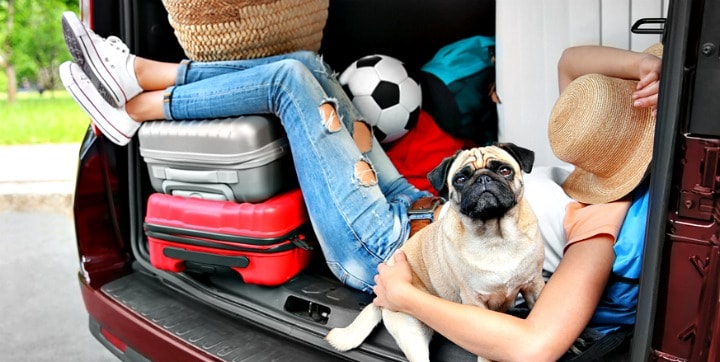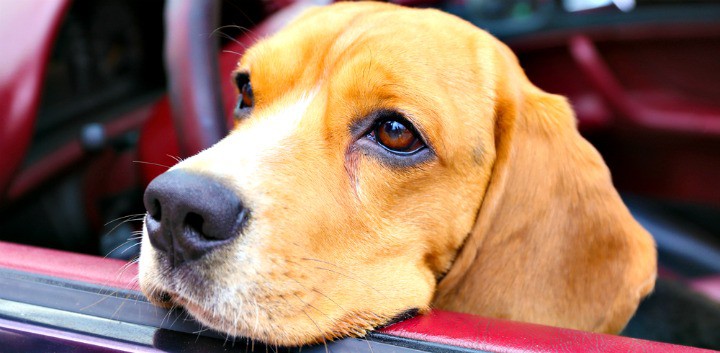How to Keep Pets Safe in Your Vehicle When Travelling

By Tim Spell
Most Americans view their dogs as “family members,” according to a study released by Volvo Car USA and Harris Poll, and 97 percent drive with them. The problem with traveling with a pet is that many owners don’t adhere to basic safety rules, especially the need to properly secure them within the vehicle.
“Loose pets in cars are a problem,” says Russell Datz, a Volvo Car USA spokesman. “In a collision they become a projectile and they can do a lot of damage both to themselves and other people in the vehicle. Everyone likes to have their dog in their lap, it’s nice and cute, but you don’t want to see what that looks like in an accident. Restrain your pets, put them in a cage in the back, put them in a harness in the back seat if you can’t do that, but don’t let them fly around loose in a car.”
Dos and don’ts for securing pets
The Center for Pet Safety points out other risks of dogs not being secured in a vehicle.
“Allowing pets to put their heads out of the car window is dangerous. While your dog’s ears flapping in the wind might be funny — road debris in his eyes can be painful and costly. Also, distracted driving can be caused by not only your cell phone, but by the family pet.”
Securing a pet in the back seat with a quality crash-tested harness is critical for its safety, reports the CPS, but “all pet safety harnesses are not created equal.” It warns against the use of long extension tethers and zipline-style products.
RELATED: How Does Pet Insurance Work?
Pet carriers are a proper means to transport a pet, says CPS, but, if size permits, put the carrier on the floor, behind the front-passenger or driver seat.
“While it is intuitive for most people to `buckle up’ their pet’s carrier — don’t — unless the manufacturer provides you with crash test video to illustrate structural integrity. Using a seatbelt to secure a carrier can actually crush the carrier if you get into an accident.”
With the popularity of sport-utility and crossover-utility vehicles with up to three rows comes the opportunity for pet owners to safely secure dogs and larger carriers or crates in the rear seats and cargo compartment.
Joint research of CPS and Subaru of America finds that pets weighing less than 20 pounds can be harnessed or secured in carriers in the second-row captain’s chair. Pets weighing more than 20 pounds should be properly secured and travel in the third-row bench, directly behind one of the captain’s chairs.
“Never place your pet on the floor between the captain’s chairs in three-row SUV models,” the study cautions, as this could result in the pet being flung across the cabin. Special precautions should be taken when traveling with both children and pets. “Secure the child in the second row and secure the pet in the third row, on the opposite side of the vehicle as the child.”
Choose the best dog crate for your vehicle
Utility vehicles also provide the opportunity to position a crate in the rear cargo area, which is especially convenient for transporting larger dogs. Crates must be firmly secured to connectors that are strong enough to maintain connection during impact.
“You can use kayak straps or other tie-downs,” CPS reports, “but your safest bet is to use Bergan tethers or another safety rated strap.”

When selecting a crate or carrier it should be no more than 6 inches longer than the pet, according to CPS, to help minimize the risk of pet injury during a sudden stop or crash. Crates and carriers can be either hard- or soft-sided, and those constructed of rotomolded plastic have gotten good reviews for strength. Wire crates aren’t recommended.
CPS conducted crate crash tests, in which it concluded that wire crates “will not provide significant protection in case of an accident.” It reported in one test with a wire crate: “While the straps kept the crate in place, the test (dummy) dog hit the back of the crate so hard that it broke through the crate and hit the seatback.”
ALSO: Guide to Gifting a Car to Someone
Safely transporting a dog in a pickup bed is possible, but “truck travel restraint is so very important,” reports CPS, “and yet it is so infrequently done, or done properly.” The safest method is an immobilized crate, positioned behind the truck’s rear window and securely fastened to the bed.
Even better, the crate should be protected by a truck cap or camper to shield the dog from inclement weather, wind and road debris.
Tethering is not a safe alternative, and is especially dangerous when done with a collar and long leash that can result in the strangulation of a dog jumping are falling out of the bed. While some sources recommend a proper tethering system with a strong harness, the Humane Society of the United States reports that no harness has proven suitable for travel in an open pickup bed.
Safe travel also means taking measures to ensure a dog stays healthy during a trip. CPS recommends: “Bring extra food, treats — and don’t forget the water. Water content changes from city to city, so it’s best to prevent digestive upset and bring bottled water or bottled tap water from home. Locate a veterinary medical provider near your travel destination. Being prepared will give you peace of mind.”
